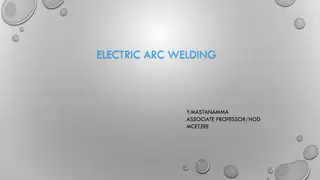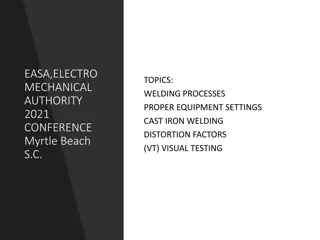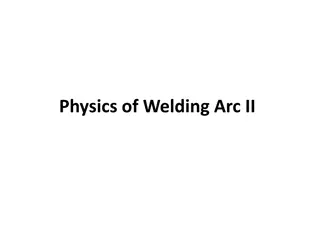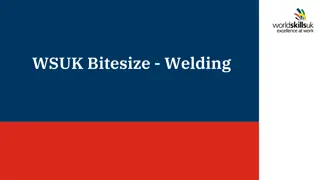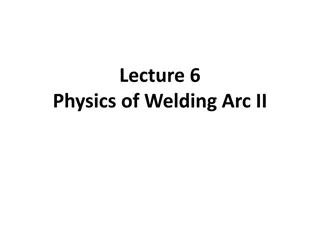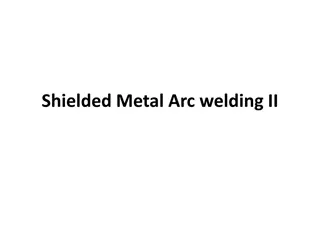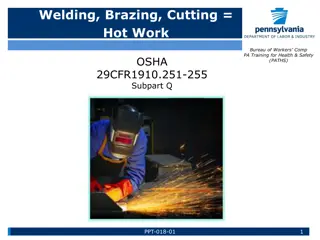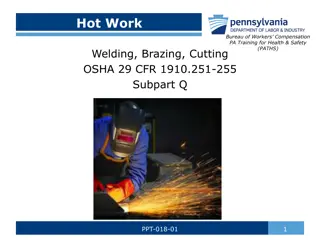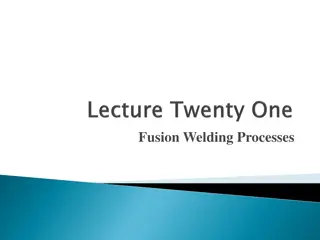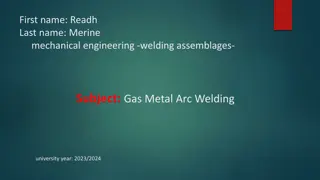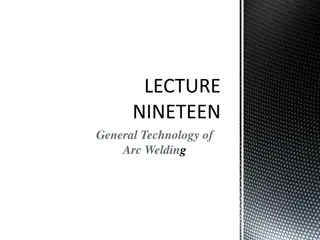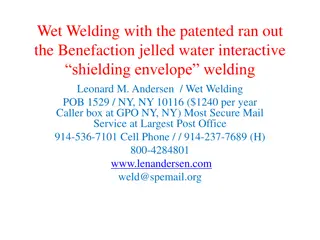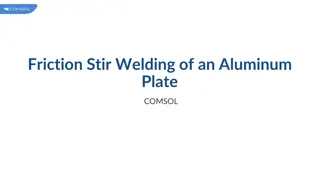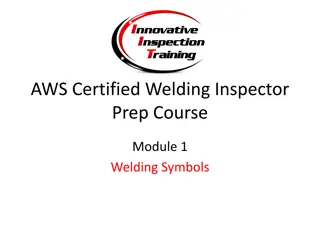Automotive Grade 12 Safety Guidelines for Welding and Joining Equipment
Learn important safety precautions for welding and joining equipment in automotive grade 12. Understand the risks associated with arc welding and gas welding equipment, and follow guidelines to ensure operator safety, proper equipment usage, and ventilation. Proper handling of equipment, protective gear, and safe practices are vital for preventing accidents and ensuring a secure work environment.
Download Presentation

Please find below an Image/Link to download the presentation.
The content on the website is provided AS IS for your information and personal use only. It may not be sold, licensed, or shared on other websites without obtaining consent from the author.If you encounter any issues during the download, it is possible that the publisher has removed the file from their server.
You are allowed to download the files provided on this website for personal or commercial use, subject to the condition that they are used lawfully. All files are the property of their respective owners.
The content on the website is provided AS IS for your information and personal use only. It may not be sold, licensed, or shared on other websites without obtaining consent from the author.
E N D
Presentation Transcript
SAFETY AUTOMOTIVE GRADE 12
Joining Equipment Joining Equipment IMPORTANT Welding or flame cutting operations may not be undertaken, unless: An operator has been instructed on how to use the equipment safely; A workplace is effectively partitioned off; and An operator uses protective equipment. Where hot work is done outside the designated workplace, the employer should obey fire precautions.
Arc Welding Equipment Arc Welding Equipment Observe the following safety precautions when using arc welding equipment: Wear approved PPE to shield the skin from the arc rays. Wear PPE that is fire-resistance to protect the welder against sparks. Never wear clothes made from synthetic material when welding. Use completely insulated electrode holders. At no time strike an arc without protecting your eyes with a helmet or welding shield. Always wear safety goggles to protect your eyes from particles of metal and chips of slag. Stand and work only in dry surroundings. Always keep your hands and clothing dry. Remove all combustible materials from the welding area and keep a fire extinguisher in close proximity. In case of a fire, unplug the welding machine before attempting to put out the fire using a fire extinguisher. Inspect the equipment regularly. Do not use the welding machine if its electrode holder, earth clamp or connectors are loose or the insulation on any part show signs of wear. Report any frayed wires. Wear leather spats and safety boots when welding.
Ensure that the ventilation of the work area is such that the operator is working in clean, fresh air at all times. Use a portable fan for extra ventilation when working on galvanised or zinc-coated steel, as these give off poisonous fumes. Welding workshops must have an extractor fan system. Use tongs and pliers, not your hands, to grasp hot metal that has been welded. Switch off the welder and disconnect it from its power source whenever you leave it unattended and whenever you are cleaning, inspecting or servicing and repairing it.
Gas Welding Equipment Gas Welding Equipment Observe the following safety precautions when using gas welding equipment: Always store, transport and use oxygen and acetylene cylinders in an upright position. Ensure that cylinders are stored upright and chained securely. Avoid oil and grease from coming into contact with oxygen cylinders, valves, regulators, fittings and gauges. Stand to the side (not in front) of the cylinder nozzles when opening the valves. Ensure that you open the gas valves very slowly, and never open the acetylene valve more than half a turn. The reason for this is that should something go wrong, the valve can be closed quickly to avoid an explosion or fire. Remember, acetylene is highly flammable. Always leave the acetylene cylinder s spindle key in place so that the valve can be closed quickly in case of an emergency. Never light the torch with a match or a gas lighter; always use a spark (tri-flint) lighter. The spark lighter gives off sparks, while matches and gas lighters give continuous flames. Gas lighters are highly explosive.
Acetylene has a distinctive foul or garlic odour. Upon smelling the odour, shut down the set immediately and attempt to find the leak using a special leak-testing solution. Open flames are very dangerous when working with gas. Ensure that all valves are shut correctly before putting down the torch. Hold hoses together with special C-clamps that enable easy splitting of hoses in case of fire. Ensure that all valves are correctly closed and pressure relieved and gases purged from the lines when shutting down.
Safety precautions when handling cylinders The following safety precautions must be observed when handling gas cylinders: No portable gas container should be used, filled, handled, modified, repaired or inspected in any way other than in compliance with standards set by the South African Bureau of Standards (SABS). Never stack cylinders on top of one another, as this would cause the cylinders to be put under huge pressure. Do not bang or work on cylinders. Leave this to the specialists. Never allow cylinders to fall. For this reason, valve guards should always be installed around cylinder valves. If a cylinder falls and a valve breaks off, it could cause a cylinder to rocket, causing havoc. Do not allow oil or grease to come into contact with oxygen fittings, as this forms a flammable mixture.
Workshop Layouts Workshop Layouts Product Layout The product layout ensures that the machines are arranged in the sequence in which operations are carried out, so that the product of first machine is processed by the adjacent machine, the product of that machine by the next machine in the line, and so on until the finished product leaves the last machine. Advantages of the product layout of machines: Handling of material is limited to a minimum. Time period of manufacturing cycle is less. Production control is almost automatic. Control over operations is easier. Greater use of unskilled labour is possible. Less total inspection is required. Less total floor space is needed per unit of production.
Disadvantages of product layout of machines: Lack of flexibility (layout cannot easily be changed to another type of production). Optimum use of equipment is not possible.
Process Layout The process layout is based on the type of manufacturing process needed in the making of the product. The flow of material is interrupted and machines are grouped according to their type of operation. A product passes through different stages of production, which are carried out in different departments such as turning, machining, drilling and grinding departments. Advantages of the process layout of machines: High machine utilisation because more than one product is manufactured. Better supervision as a result of subdivision of processes. Less interruption in flow of work when machines become defective. Lower equipment cost, since one machine can produce more than one product. Better control of total manufacturing cost. Greater flexibility in the production process.
Disadvantage of process layout of machines are: Production is not always continuous. Transportation costs between process departments may be high. Additional time is spent in testing and sorting as the product moves through the different departments. Damage to fragile goods may result from extra handling.
Analysing the OHS Act and Regulations Analysing the OHS Act and Regulations Occupational safety can be divided into two main categories, namely: Conditions: the responsibility of the employer Actions: the actions and the behaviour of the employee; in other words, you! Conditions: These refer to, for example, the conditions of the workshop building, floor and grounds. The employer must see to it that the aforementioned areas are in a good condition and that workers report any substandard conditions. Actions The actions referred to here are those of the workers. Irresponsible, unsafe or undisciplined actions can lead to accidents or disciplinary actions. You, as an employee, must make a point of finding out what is regarded as acceptable and safe behaviour and what is not. You must be safety-conscious at all times.
OHS Act OHS Act The Occupational Health and Safety Act as amended, No 181 of 1993 prescribed responsibilities of employers and employees as follows: General duties of employers to their employees 1. Every employer shall provide and maintain, as far as is reasonable practicable, a working environment that is safe and without risk to the health of his employees. 2. Without derogating from the generality of an employer s duties under subsection (1), the matters to which those duties refer include in particular- The provision and maintenance of systems of work, plant and machinery that, as far as is reasonably practicable, are safe and without risks to health; Taking such steps as may be reasonably practicable to eliminate or mitigate any hazard or potential hazard to the safety or health of employees, before resorting to personal protective equipment; Making arrangements for ensuring, as far as is reasonably practicable, the safety and absence of risks to health in connection with the production, processing, use, handling, storage or transport of articles or substances; Establishing, as far as is reasonably practicable, what hazards to the health or safety of persons are attached to any work which is performed, any article or substance which is produced, processed, used, handled, stored or transported and any plant or machinery which is used in his business, and he shall, as far as is reasonably practicable, further establish what precautionary measures should be taken with respect to such work, article, substance, plant or machinery in order to protect the health and safety of persons, and he shall provide the necessary means to apply such precautionary measures;
Providing such information, instructions, training and supervision as may be necessary to ensure, as far as is reasonably practicable, the health and safety at work of his employees; As far as is reasonably practicable, not permitting any employee to do any work or to produce, process, use, handle, store or transport any article or substance or to operate any plant or machinery, unless the precautionary measures contemplated in paragraph (b) and (d), or any other precautionary measures which may be prescribed, have been taken; Taking all necessary measures to ensure that tire requirements of this Act are complied with by every person in his employment or on premises under his control where plant or machinery is used; Enforcing such measures as may be necessary in the interest of health and safety; Ensuring that work is performed and that plant or machinery is used under the general supervision of a person trained to understand the hazards associated with it and who have the authority to ensure that precautionary measures taken by the employer are implemented; and Causing all employees to be informed regarding the scope of their authority as contemplated in section 37 (1) (b).
Duty to inform Without derogating from any specific duty imposed on an employer by this Act, every employer shall- As far as is reasonably practicable, cause every employee to be made conversant with the hazards to his health and safety attached to any work which he has to perform, any article or substance which he has to produce, process, use, handle, store or transport and any plant or machinery which he is required or permitted to use, as well as with the precautionary measures which should be taken and observed with respect to those hazards; Inform the health and safety representatives concerned beforehand of inspections, investigations or formal inquiries of which he has been notified by an inspector, and of any application for exemption made by him in terms of section 40; and Inform a health and safety representative as soon as reasonably practicable of the occurrence of an incident in the workplace or section of the workplace for which such representative has been designated.
General duties of employees at work Every employee shall at work- Take reasonable care for the health and safety of himself and of other persons who may be affected by his acts or omissions; As regards any duty or requirement imposed on his employer or any other person by this Act, co- operate with such employer or person to enable that duty or requirement to be performed or complied with; Carry out any lawful order given to him, and obey the health and safety rules and procedures laid down by his employer or by anyone authorized thereto by his employer, in the interest of health or safety; If any situation which is unsafe or unhealthy comes to his attention, as soon as practicable report such situation to his employer or to the health and safety representative for his workplace or section thereof, as the case may be, who shall report it to the employer; and If he is involved in any incident which may affect his health or which has caused an injury to himself, report such incident to his employer or to anyone authorized thereto by the employer, or to his health and safety representative, as soon as practicable but not later than the end of the particular shift during which the incident occurred, unless the circumstances were such that the reporting of the incident was not possible, in which case he shall report the incident as soon as practicable thereafter.
Duty not to interfere with, damage or misuse things No person shall intentionally or recklessly interfere with, damage or misuse anything which is provided in the interest of health or safety.
SELF SELF EVALUATING ACTIVITY 2 EVALUATING ACTIVITY 2 1. Arc Welding Equipment 2. Gas Welding Equipment 3. Handling of Gas Cylinders 4. Although everyone in a workshop must practise safety and safety is everybody s responsibility, the OHS Act (Occupational Health and Safety Act, No. 85 of 1993) prescribes specific responsibilities of the employer and employee. 5. Describe the employer s responsibilities. 6. Describe the employees responsibility.




